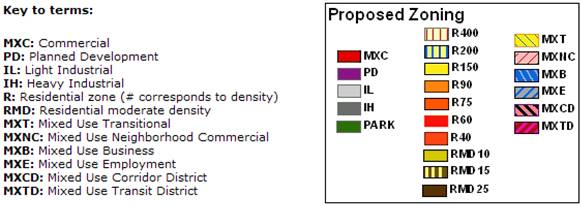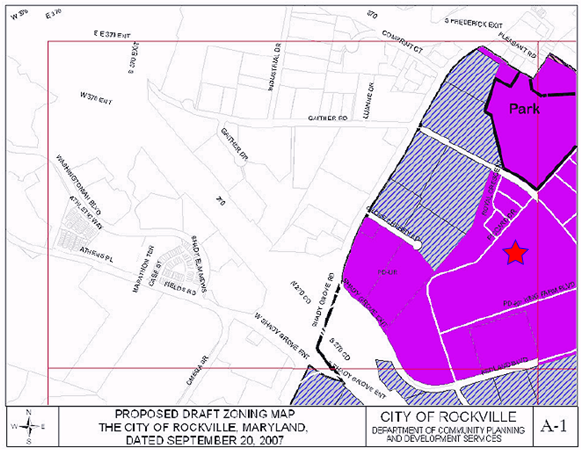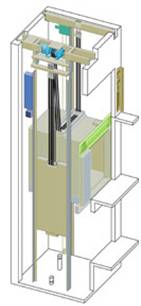Use the scroll bar to the right to view the rest of this page.
Part 1
General Building Data:
- Building Name: Ingleside at King Farm
- Location and Site:
1623 Piccard Drive Unit A
Rockville, MD 20850
11.5 acre site in suburban Washington, DC - Building Occupant Name: King Farm Presbyterian Retirement Community, Inc.
- Occupancy or function types (type of building):
- Senior Living: Continuing Care Retirement Community with Mixed Occupancies
- Assembly
- Healthcare
- Residential-Apartment
- Community complex consisting of apartments
- Residential-Board and Care
- Special Needs Housing
- Interpretive Care
- Storage-Ordinary Hazar
- Size (total square feet): 790,000 SF
- Number of stories above grade/total levels: 7 stories above grade/8 levels total; Below-Grade Garage
- Primary project team:
- Owner: Ingleside Presbyterian Retirement Community
- Owner’s Representative: Jeffrey Powell Company
- General Contractor: Turner Construction Company
www.turnerconstruction.com
- Construction Manager: Turner-Konover
www.turnerconstruction.com & www.konoverconstruction.com
- Architects:
Arthur Shuster
www.arthurshusterinc.com
CSD People Architecture
www.csdarch.com
- Engineers:
- Consultants:
Loiederman Soltesz Associates
www.lsassociates.net
Morabito Consultants, Inc.
www.morabitoconsultants.com
Siegel, Rutherford, Bradstock and Ridgway Inc.
www.srbr.com
Culinary Design Service
- Dates of construction (start – finish):
ECS, Ltd.
www.ecslimited.com/index.cfm
Mandel & Associates, INC.
Whitlock Dalrymple Poston & Associates, Inc.
www.wdpa.com
- Construction Start (Footings): 3/15/2007
- Construction Finish (Substantial Completion): 1/15/2009
- Cost Info:
- $97,000,000-GMP Overall Project Cost (construction only; “bricks and mortar”)
- $101,900,000-Current Indicated Cost
- $1,500,000-Upgrades (counters, finishes, etc.)
- $3,400,000-Change Orders
- Project delivery method: Construction Manager; Joint Venture
Architecture:
- Architecture (design and functional components)
- The building appears to be a large mansion designed with a combination of Colonial and Second Empire architecture styles. There are 13 different apartment unit floor plans in the various living units. It has 8 levels consisting primarily of an above grade structure and a below grade parking garage. There is a large open courtyard on the south side of the building; laid out between the 2 major wings of the building.
- The building incorporates some sustainable elements into the design such as the use of high-efficiency faucets, lo flush toilets, cross linked polywater tubing (PEX). low E glass, high-efficiency air handling equipment, plantings over the plaza (garage roof slab), feature pond on the project’s North side, low VOC coatings.
- The building serves primarily as a Continuous Care Retirement Community with a multitude of functional components. There are 244 Independent Living Units, 43 Assisted Living Units, 16 Skilled Nursing Units, 10 Dementia Units to house residents with varying requirements. It also contains Restaurants and a Theatre Room for entertainment. Residents have access to an Olympic Size Swimming Pool and Tennis Court to keep active.
- Buildings constructed in Rockville, MD must comply with the major building codes enforced by the Inspection Services Division of the Community Planning and Development Services Department. In addition, they must comply with the Rockville City Code. Enforced codes are listed below. http://www.rockvillemd.gov/business/licenses/isd.htm
- 2003 International Building Code
- 1997 International Plumbing Code
- 1996 International Mechanical Code
- 1996 National Electrical NFPA-1
- 2003 NFPA-1
- 2003 NFPA-101
- 2002 NFPA 13
- 2002 NFPA 72
- ASTM A17.1 2004 & 20005.1S
- Rockville City Code http://www.rockvillemd.gov/government/citycode.htm
- Ingleside is located in a Planned Development Zone.


- There were no historical requirements for this project.
- The building envelope consists of 3 major assemblies; split face masonry, ground face masonry, and simulated stucco. The garage level is constructed primarily of split face masonry on a poured concrete wall with a 2” air space. The ground/first floor consist of 5/8” foil faced gypsum board, 6” metal studs, 6” batt insulation (unfaced), 5/8” exterior sheathing, Tyvek building wrap, 2” air space, and ground face masonry. The second floor through the seventh floor consist of 5/8” foil faced gypsum board, 6” metal studs, 6” batt insulation (unfaced), 5/8” exterior sheathing, and simulated stucco.
- The roofing system also varies. The most prominent portion of the roof is a mansard style roof constructed out of light gauge metal framing with metal shingles. The concealed portion of the roof consists of a roof membrane on 1½” metal deck supported by 8” steel “C” channels and steal beams. The 7th floor has low roofs that green roof gardens and are constructed either from poured in place concrete or metal deck with roof insulation system, membrane roof waterproofing system, and a protection layer.
- There are 3 basic types of windows that also form 7 different window assemblies; double hung, picture, and bay. The mansard roof contains dormer windows, which project out from the roof structure. The windows are all manufactured with PVC frames and 5/8” double light insulating glass set with marine glazing.
Part 2
Primary Engineering Systems:
Construction:
Turner and Konover entered into a joint venture contract to deliver this project as a CM agent; fees are divided giving Turner 51% and Konover 49%. Turner is the General Contractor (GC) and they cover the protection of the safety contractor and labor. The developer, Penrose Group, helped finance this project for the owner to bring affordable living to Rockville seniors.
Construction equipment used for this project includes tower 2 tower cranes with a 230’ reach and a maximum lifting capacity of approximately 13 tons. They’re used primarily to hoist concrete buckets from the on-site batch plant into place for the construction of the superstructure. The footprint of the building is very long so this requires the use of somewhat large cranes, which must be placed in close enough proximity that they are at risk of crossing paths. Careful coordination will maintain safety.
Some special systems associated with the project include a Surveillance System and a Visual/Voice Nurse Call System. More detailed explanations of the main engineering systems are called out below, which also corresponds to Technical Assignment 1.
Electrical:
Power is fed from 2 locations; one on the west end and one on the east end. Both services #1 and #2 have a 4000 Amp Main at 480/277 V. They are 3-phase with 4 wires. This creates an interesting coordination issue trying to keep the panel feeders in order. A 750 KW Emergency Generator is also located in the basement and provides power for some of the critical items listed below:
- Emergency Lighting
- Fire pump
- Elevators
- Door Controls
- Food Service Refrigerators/Freezers
- Toilet Exhaust Fans
- Water Source Heatpumps
- Standpipe Power
- Day Tanks
- Boilers
Lighting:
The lighting for common areas is primarily provided using a form of compact fluorescent lighting, which is in line with the anticipated LEED rating and energy conservation effort. The lighting controls are somewhat typical and do not have any provisions for occupancy sensors/timers. On/off is the primary control of the interior systems. The exterior systems utilize primarily High Intensity Discharge (HID) lighting for the exterior pathways and landscaping. The roof gardens use primarily incandescents.
Mechanical:
Ingleside at King Farm’s Mechanical Rooms & Boiler Room are located in the Northwest end of the Garage. There are Gas-Fired Rooftop Units, which make a Constant Volume Air System throughout and maintain a positive pressure in the corridors to prevent cross-contamination between living units. Induced Draft Cooling Towers are located on the roof with a Plate and Frame Heat Exchanger in Garage to serve the Heatpump Loop. This Heatpump loop contains Water Source Heatpump Units in each of the living units for individual control. Gas-Fired Forced Draft Hot Water Boilers in the basement provide the hot water for the Water Source Heatpump Units. Electric baseboard used to provide an additional stage of heat when needed. Ductless Split Systems serve the memory assist living units.
The Garage is partially finished. The parking area is heated with small individually controlled electric Unit-Heaters and the exhaust gases are removed with large exhaust fans on the north side of the building. The offices and storage areas are served by their own Water Source Heatpumps.
Structural:
This structural system is a two-way framing system that contains a 8” concrete Post-Tensioned floor systems and a 12” first floor. The post-tensioned superstructure consists of flat plate floor slabs with 8.5’ x 8.5’ x 10” drop panels on the first floor and 10’ x 10’ x 5.25” drop panels on the seventh floor. The drop panels for the first floor help support the central courtyard above the Garage and the drop panels on the seventh floor prevent the steel columns from causing punching shear with the floor, which would cause collapse. The seventh floor exterior walls are framed using steel columns. The roof is framed using light gauge steel for the sloped sections, which is supported by a concrete roof slab around the perimeter of the building. The middle portion of the roof is constructed with K-Joists supporting 20 gauge galvanized roof deck. Excluding shaft walls, the building has four one foot thick shear walls to support lateral loads such as wind. The shear walls extend from the Garage through the seventh floor.
Additional Engineering and Engineering Support Systems:
Fire Protection:
Ingleside at King Farm is to be a fully sprinklered building using automatic wet pipe system and dry system in areas prone to freezing such as the garage. This is an active system. The Fire Protection Systems and Equipment are regulated by the National Fire Protection Association Pamphlet 13 (NFPA 13). An NFPA 101 code search determined the fire construction type as Type I-332 Construction; building elements are of noncombustible materials.
 Transportation:
Transportation:
Transportation throughout the building is handled via a quantity of 7 OTIS Gen2 Machine Roomless elevators. Although the name implies that the elevators do not require a machine room, they still require a remote space for some of the power distribution and controls. These elevators are the new generation of inter-building transportation and are geared to more efficient use of space, energy reduction, and reduced installation time. The maintenance costs and energy savings with these elevators are significant and will be realized immediately by the owner.
Telecommunications:
All the telecommunications, phone and internet (CAT5E) and cable TV (CATV), are fed from the east side of the building through 4” conduits as directed by the CATV company and Verizon. Each living unit has provisions for hard-wired internet hook up, telephone, and TV.
Special Systems, Special Uses or Unique Aspects of the Building:
The Garage was not previously explained in great detail. It is partially finished and is used for the administrative staff offices and some resident storage. Some other items that were not previously detailed include the additional amenities. Ingleside at King Farm is intended to provide its senior residents with affordable and comfortable living. Everything to sustain a happy, healthy, and stress-free life is found under the roof and between the walls of this building. The first floor features the majority of the community gathering spaces such as the Bistro, the Bar, the Full-Service Kitchens, the Demonstration Kitchens, the Common Dining Restaurants, the Private Dining, the Market Place, the Multi Purpose Room and Auditorium, the Game Room, the Conference Room, the Sitting Room, the Library, the Computer Room, the Living Room, the Bank, the Mail Room, the Beauty Salon and Massage Room, the Arts/Crafts Room, the Fitness Room and access to the future Pool area. Each area is essentially a separate space and each has its own design challenges associated with it.
The site lies between 2 Forest Conservation areas to the east and west of the property. This provides an appealing buffer between adjacent land owners. In addition to the natural vegetation surrounding the property, the project calls for a fairly large amount of landscaping and roof garden work. Included in the plans are 24 different species of deciduous shade trees, ornamental trees, and evergreen trees totaling 198. There will be 740 deciduous and evergreen shrubs, which is broken up into 19 species. 24 different species of ornamental grasses, perennials, and groundcovers add up to 3,291 units. Although this helps beautify the property, it does not contribute to the water efficiency of the site. Further research is required to determine if there are opportunities to maintain the site appearance and reduce water usage with the use of more native plant species and alternative treatments. On the contrary, some facility owners report that extensive landscaping surrounding your building reduce HVAC equipment maintenance/operation costs, reduce cleaning costs, and improve indoor air quality (IAQ).











